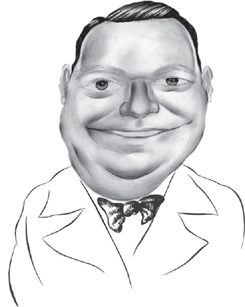

“The only place in America to get a drink is the police station.”
At five foot ten and 275 pounds, Fatty Arbuckle earned his nickname. Of his over 150 films, the best known are The Rounders (with Charlie Chaplin, 1914) and the unconventional Western The Round-Up (character name: Slim Hoover, 1920). Arbuckle also wrote and directed most of his own films. In 1918 he became the first $1-million-per-year movie actor. In 1921 he was implicated in the sexual assault and accidental death of actress Virginia Rappe. Arbuckle was acquitted after three trials, but he did not receive a film contract for the next eleven years. With no means of employment, in 1928 he opened the popular, though short-lived, nightclub Plantation Café, in Culver City. His acting comeback finally began in 1932. A year later, the night before he was to sign his first talkie, Arbuckle had a party to celebrate. He left early, went straight to bed, and died in his sleep from a heart attack.
EARLY ONE MORNING IN 1920, housekeepers at the Sunset Boulevard mansion of actress Pauline Frederick heard a commotion outside. They emerged to discover a car blithely parked in the middle of the front lawn and three utility workers digging toward a leaky gas pipe. The housekeepers screamed for the workers to stop; Frederick had just paid an enormous sum to have the 150-foot lawn perfectly manicured, and now her flawless grass was being destroyed. The workers were unmoved. There could be an explosion, for God’s sake. Finally, Frederick herself dashed out of the house in a bathrobe, shouting and weeping. But as she neared the truck, her screams abated and something entirely unexpected occurred: Frederick broke into laughter.
Two of the “gasmen,” it turned out, were none other than superstar Fatty Arbuckle and his newest partner in crime, Buster Keaton—both well in their cups.
Arbuckle’s unquenchable thirst for good scotch was already legendary inside Hollywood. He threw lavish parties on any occasion, however slight. One such party was for the wedding of two dogs. The basement of his Tudor mansion on West Adams was stacked floor to ceiling with expensive wine and scotch. He owned a custom $25,000 Pierce-Arrow phaeton car with a bar and toilet inside. Perhaps that is worth repeating: He had a toilet inside his car.
Arbuckle’s unquenchable thirst for good scotch was already legend inside Hollywood. He threw lavish parties on any occasion, however slight. One party was for the wedding of two dogs.
A typical Arbuckle night involved lobster, scotch, a party (his or someone else’s), and the occasional orgy. It was thus that he ended up on Polly Frederick’s front lawn. The idea for the prank had been born several weeks earlier, when Arbuckle drove past Frederick’s home and deemed the front lawn insultingly well kept. Resolved to do something about it, he hatched the gasman plan, enlisting best friend, Keaton.
For her part, Frederick was gracious about the entire affair. After explaining to her housekeepers what was happening, she scolded the pranksters with a smile and invited them inside for breakfast.
BUILT ON A THREE-ACRE strawberry patch fronting the dusty, unpaved road that would become Hollywood Boulevard, the Hollywood Hotel was the town’s first proper nightspot. Stucco, Moorish style, it was a mecca for arriving talent, as well as the early giants of the industry: actors, directors, producers.
Originally named the Hotel of Hollywood, but always called the Hollywood Hotel, the establishment had two watershed moments within its first decade. The first came in 1906, when sixty-three-year-old heiress Almira Hershey (of the chocolate dynasty) rode up from her Bunker Hill mansion to eat lunch at the hotel and ended up buying the place. Apparently things like this actually did happen, once upon a time.
The second was in 1910, when New York’s Biograph Studios sent director D. W. Griffith to shoot three films in Los Angeles, and he discovered the charms of its suburb (Hollywood) — and its freedom from the expensive patent licenses required to film in New York. Within five years, most of the film industry had relocated to Hollywood, and virtually everyone’s first home was the Hollywood Hotel. Its registry is now in the Smithsonian.
During those early years, it was the only acceptable hotel in Hollywood in which to reside, with a Thursday night dance that became quite the scene—the city’s very first “place to be seen.” Hershey didn’t allow drinking or cohabitation, but she was the only person who enforced those rules—and she was in her seventies and nearly blind. The result, to read contemporary accounts, was some combination of a frat house and an insane asylum, with ill-behaved actors drinking openly in the very dining room she policed. A besotted Fatty Arbuckle was known to use his napkin to catapult butter packets onto the ceiling, which then melted and dropped down at the next seating.
The most famous room, 264, was the honeymoon suite out of which Jean Acker locked Rudolph Valentino on their wedding night, afraid to tell him she was a lesbian. Legend has it that Miss Hershey paid a visit to one bed-hopping actress every night to assure that no untoward activity was taking place. The actress always timed her trysts accordingly, until one night Hershey caught her. She was evicted at dawn. Two hours later, the actress returned with a new hairstyle, fake accent, and a pseudonym. Miss Hershey checked her right in.
Inevitably, stars bought mansions, and new hotels and nightclubs emerged; by the time Hershey died in 1930, at age eighty-seven, the Hollywood Hotel had become a quaint relic. It was torn down in 1956, and today the location houses an abominable megamall, the only graceful note of which is the Dolby Theatre, which hosts the Academy Awards on the same plot of land that sprouted the film industry a century before.